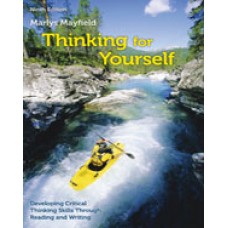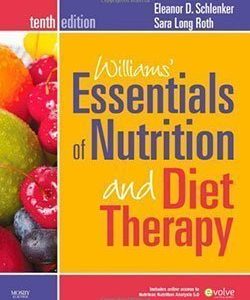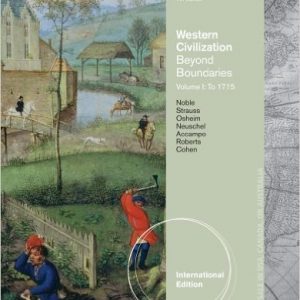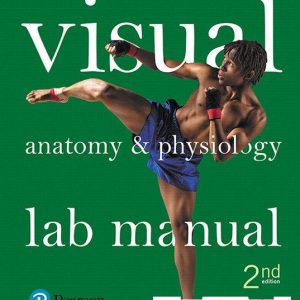Instant download Test Bank for Thinking for Yourself, 9th Edition pdf docx epub after payment.

Product details:
- ISBN-10 : 1133311180
- ISBN-13 : 978-1133311188
- Author: Marlys Mayfield (Author)
THINKING FOR YOURSELF: DEVELOPING CRITICAL THINKING SKILLS THROUGH READING AND WRITING offers a unique integration of composition, reading, and critical thinking. As you complete the book’s writing assignments, you’ll see how your writing reflects your thinking and how self-directed improvement in thinking also improves your writing. The book offers step-by-step instruction, humor, cartoons, and up-to-date social and political examples as a foundation for lifelong improvement in thinking and writing.
Table of contents:
Preface. Introduction. Introduction to Critical Thinking. Learning How You Think. Discovery Exercise. Experiencing How We Actually Think: An Exercise for the Whole Class to Complete Together. Learning from Sharing How We Think. What Is Critical Thinking? Relationship to Creative Thinking. Diagram: Different Functions of Left and Right Brain. Why Learn Critical Thinking? The Habits of a Critical Thinker. Box: Habits of a Critical Thinker. Part I: BASICS OF CRITICAL THINKING. 1. Observation Skills: What’s Out There? Discovery Exercises. Comparing Our Perceptions. What Is Observing? Observing a Cube. Observation and Insight. Using Observation Skills to Develop New Knowledge. Reading. Look at Your Fish, by Samuel H. Scudder. Core Discovery Writing Application. Observing the Familiar: Vegetables and Fruit. Evaluating Your Work by Using the Scoring Boxes. Alternate Core Discovery Writing Application. Observing the Unfamiliar: A Tool. The Observation Process: Sensing, Perceiving, Thinking. Barriers to Observation. How Discomfort Leads Us to Think. Diagram: A Choice for Thinking. The Rewards of Skilled Observation. Building Arguments. Observation Skills. Reading. The Innocent Eye, by Dorr Bothwell. Chapter Summary. Chapter Quiz. Composition Writing Application. Survival as a Result of Observing: A Descriptive Narrative Essay. Readings: God Grew Tired of Us by John Bul dau,Walking by Paul Krafel, Spanish Harlem at Night by Ernesto Quinonez. 2. Word Precision: How Do I Describe It? Discovery Exercise. On Finding the Right Word. Discovery Exercise. Taking an Interest in Dictionaries. How Well Do You Use Your Dictionary? Clear Thinking Depends on Clear Word Definitions. What Makes a Definition? Diagram: Definition Boundaries. Exercise. Word Boundaries. Kinds of Definitions. The Connotations of Words. The Importance of Defining Key Ideas. Word Concepts. Defining Reality. Defining Truth. What Is Critical Reading? Building Arguments. Word Choices. Chapter Summary. Chapter Quiz. Composition Writing Application. A Short Essay of Definition. Box: Clustering. Readings. Rankism by Robert W. Fuller, Nerds by David Anderegg, Saved by Malcom X. Advanced Optional Writing Assignment. 3. Facts: What’s Real? Discovery Exercises. Beginning with the Word Fact. Learning to Recognize Facts. Verifying Facts. Facts and Reality. Facts Are Not Absolutes. Distinguishing Facts from Fiction. Feelings Can Be Facts. Facts and Social Pressure. Diagram: Standard and Comparison Lines in the Asch Experiment. Facts and Our Limited Senses. Reading. The Blind Men and the Elephant. Statements of Fact. Core Discovery Writing Application. Using a List of Facts to Describe a Photograph. Standards We Use to Determine Facts. Chapter Summary. Chapter Quiz. Composition Writing Application. Writing a Short Fact-Finding Report. Readings: Our Daily Meds by Melody Peterson, Fast Food Nation by Eric Schlosser. Building Arguments. Advanced Optional Writing Assignment 4. Inferences: What Follows? Discovery Exercise. Recognizing Inferential Thinking. Defining Infer, Understanding the Words Infer and Inference. Discovery Exercises. Drawing Inferences from Evidence. Drawing Inferences from Facts. Distinguishing Inferences from Facts. How Inferences Can Go Right and Wrong. Reading. The Adventure of the Speckled Band by Sir Arthur Conan Doyle. Drawing Inferences from Careful Observation. Core Discovery Writing Application. Using Facts and Inferences to Describe a Photograph. Generalizations Are Inferences. Composition Writing Application. Writing a Paragraph from Facts, Inferences, and Generalizations. Core Discovery Writing Application. Analyzing the Use of Facts and Inferences in a Newspaper Article. Reading. Tougher Grading Better for Students. Building Arguments:Inferences. Chapter Summary. Chapter Quiz. Readings. Friends by Tim O’Brien, He Fixes Radios by Thinking by Richard P Feynman, The Mistake of the Sand Flea by Paul Krafel. Objectives Review of Part I. Part II: PROBLEMS OF CRITICAL THINKING. 5. Assumptions: What’s Taken for Granted? Discovery Exercise. Defining Assumption? Finding Assumptions in Cartoons, Finding Assumptions in Stories, Understanding Assumptions, Types of Assumptions. Identifying Hidden Assumptions in Reasoning. Hidden Assumptions in Arguments, Diagram: Argument with Rug of Assumptions. Discovery Exercise. Articulating Hidden Assumptions Underlying Arguments. Value or Belief Assumptions. Assumption Layers in Arguments. Diagram: Pyramid of Value Assumptions. Assumptions, Incongruities, and Thinking. Building Arguments: Assumptions. Chapter Summary. Chapter Quiz. Composition Writing Application. Expository Essay: Solving a Problem by Uncovering Assumptions. Diagram: Thesis as a Frame. Readings. Lateral and Vertical Thinking, by Edward de Bono, An Unexpected Experience by David Wood, In the Supermarket by John Bul dau, Advanced Optional Writing Assignment. 6. Opinions: What’s Believed? Discovery Exercises. Comparing a Sample of Opinions. Why Do We Get Confused by the Word Opinion? An Exercise in Evaluating Opinions. Types of Opinions. Distinguishing between Responsible and Irresponsible Opinions. Contents ix. Looking at Public Opinion Polls. Opinions as Claims in Arguments. Diagram: Argument Structure. Composition Writing Application. First Option: A Short Argument Supporting an Opinion. Second Option: A Short Expository Essay about an Opinion. Third Option: A Short Essay Analyzing Three Opinions. Peer Review. Chapter Summary. Building Arguments. Opinions. Chapter Quiz. Readings. Children Deserve Veterinary Care by Barbara Ehrenreich, Facing Up to Failure by William Ecenbarger, Rachel Carson and The Silent Spring by Al Gore. Advanced Optional Writing Assignment. 7. Evaluations: What’s Judged? Discovery Exercises. Defining Evaluate. Recognizing Evaluative Words. On Evaluations. Premature Evaluations. Evaluations Are Not Facts. Expectations Influence Evaluations. Recognizing Evaluations in Word Connotations. Discovery Exercise. Recognizing Evaluative Words’ Persuasive Powers. Skilled Use of Evaluations. Readings. Million Dollar Brutality by Vicki Haddock, Propaganda and Hidden Evaluations, Building Arguments: Evaluations. Chapter Summary. Chapter Quiz. Composition Writing Application. First Option: Observing and Analyzing Evaluations in Advertisements. Second Option: Writing a Critical Review. Readings. I Got This Part by Margaret Chao, The N Word by Jabari Asim, Awakening from the Nightmare of Zoos by Derrick Jensen. 8. Viewpoints: What’s the Filter? Discovery Exercises. Understanding the Term Viewpoint. What Types of Viewpoints Are There? Viewpoints in Literature. On Unconscious Viewpoints. Discovery Exercise. Recognizing Political and Social Points of View. Diagram: The Left-to-Right Political Spectrum. Reading. Table: Traditional Values of U.S. Conservatives and Liberals. Discovery Exercise: Learning to Recognize Political Viewpoints Composition Writing Application: A Survey of Some Alternative Viewpoints Hidden Viewpoints: The Use of News Framing. Discovery Assignment. Observing How a Newspaper Frames Its Information. Chapter Summary. Building Arguments: Viewpoints. Chapter Quiz. Readings. I Got This Part by Margaret Chao, The N Word by Jabari Asim, Awakening from the Nightmare of Zoos by Derrick Jensen. Objectives Review of Part II. Part III: FORMS AND STANDARDS OF CRITICAL THINKING. 9. Argument: What’s a Good Argument? Discovery Exercise. Reading and Judging Arguments. Critical Reading of Arguments. What Viewpoint Is the Source of This Argument? What Is the Issue of Controversy? Is It an Argument or a Report? Box: Arguments and Reports: Different Purposes, Structures, and Standards. How Is the Argument Structured in Terms of Reasons and Conclusions? Identifying the Conclusion of an Argument. Identifying Reasons. Exercise. Identifying Reasons and Conclusions. More on Distinguishing Reasons from Conclusions. Exercise. More Practice in Identifying Reasons and Conclusions. Exercise. More Practice with Longer Arguments. Core Discovery Writing Application. Writing a Short Persuasive Argument: A Letter of Complaint. What Are the Strengths and Weaknesses of This Argument? Detecting Missing Information. Detecting False or Contradictory Information. Discovery Exercise: Following up on Missing Information. Chapter Summary. Readings. Illegal Immigration is a Crime by Federation for Immigration Reform, Mayday for Undocumented Workers by David Bacon. 10. Fallacies: What’s a Faulty Argument? Discovery Exercise. Recognizing Fallacies. Fallacies That Manipulate Through Language, Through Emotions, Through Distraction. Word Ambiguity. Misleading Use of Euphemisms. Prejudicial Language. Fallacies That Manipulate Emotions. Emotional Appeals to Fear and Pity. Appeal to False Authority. Appeal to Prejudice: Personal Attack and Poisoning the Well. Fallacies That Manipulate Through Distraction. Red Herring. Pointing to Another Wrong, Straw Man. Circular Reasoning. Chapter Summary. Chapter Quiz. 11. Inductive Reasoning: How Do I Reason from Evidence? Discovery Exercises. Defining Key Terms. Answering a Survey on Test Performance. Looking at Inductive Reasoning. Reasoning from Sensory Observation. Reasoning from Enumeration. Analogical Reasoning. Discovering Patterns. Reasoning from and about Causes. Reasoning with Hypotheses. Reasoning through Statistics and Probability. Composition Writing Application. Working from Facts to Inferences to Hypotheses. Summary Building Arguments. Quiz: Inductive Reasoning. Reading. Beekeeping by Sue Hubbell. 12. Fallacies of Inductive Reasoning. The Hasty Generalization. The Either-Or Fallacy, or False Dilemma. The Questionable Statistic. Contradictions and Inconsistencies. The Loaded Question. The False Analogy. Discovery Exercise. Evaluating Analogies. False Cause. The Slippery Slope. Summary. Quiz. Advanced Optional Short Research Assignment. Detecting Fallacies in an Argument. 13. Deductive Reasoning: How Do I Reason from Premises? Discovery Exercises. What Is Deductive Reasoning? Evaluating Deductive Arguments. About Deductive Reasoning. The Basic Vocabulary of Logic. Reasoning. Syllogism. Premises and Conclusion. Validity. Soundness. Standardized Forms in Syllogisms. Discovery Exercise. Practice in Constructing Syllogisms. What Syllogisms Do. What Is Said and Is It True? Is There a Hidden Premise? Is the Reasoning Correct? Exercise. Reviewing the Vocabulary of Logic. Summary: The Interplay of Inductive and Deductive Reasoning. Box: Comparing Inductive and Deductive Reasoning. Composition Writing Application. Writing a Deductive Argument. Building Arguments: Deduction. Chapter Summary. Chapter Quiz. Readings. The Declaration of Independence (excerpt), by Thomas Jefferson. Letter from a Birmingham Jail (excerpt), by Martin Luther King, Jr. Objectives Review of Part III. Appendix: The Research Paper. Research Paper Assignments in This Text. Two Research Writing Applications: First Research Option Second Research Writing Option. Student Model Paper: Analysis of Two Arguments on the Issue Is Illegal Immigration a Crime that is Harming America? Glossary. Index.
People also search:
Thinking for Yourself, 9th Edition
Thinking for Yourself, 9th Edition pdf
Thinking for Yourself
how to start thinking for yourself
why is thinking for yourself important





